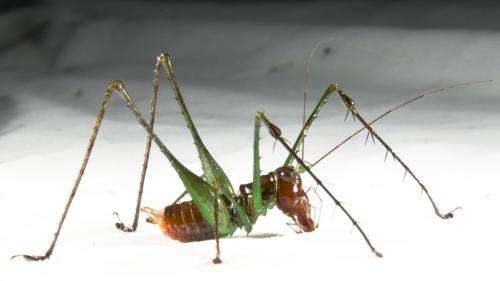Hearing capabilities of bushcrickets and mammals

A detailed review of the functional mechanics of katydid (bushcricket) hearing, draws distinct parallels between the ear of the bushcricket and tetrapods.
Dr Fernando Montealegre-Z, from the School of Life Sciences, University of Lincoln, UK, together with Professor Daniel Robert from the University of Bristol, aim to present in detail the functional mechanics of katydid hearing, drawing a parallel between the ear of the bushcricket and tetrapods.
The paper has been published in a special issue of the Journal of Comparative Physiology dedicated to research in insect hearing.
In the animal kingdom many species must identify environmental sounds to increase their chance of survival. Therefore, animals have evolved a vast diversity of mechanisms to detect sounds. Acoustic communication occurs in many groups of animals. Yet, due to their biological diversity, insect species constitute a large percentage of the acoustic community – particularly cicadas, crickets, katydids and grasshoppers. In these groups, males sing to attract females. The Tettigoniidae (or bushcrickets) ear has evolved in the context of intraspecific communication and predator detection.
Dr Montealegre-Z said: "Some insects, like katydids, have evolved biophysical mechanisms for auditory processing that are remarkably equivalent to those of mammals. Located on their front legs, katydid ears are small, yet capable of performing several of the tasks usually associated with mammalian hearing. These tasks include air-to-liquid impedance conversion, signal amplification, and frequency analysis.
"Katydids and tetrapods have evolved remarkably different structural solutions to common biophysical problems. This paper discusses the biophysics of hearing in katydids and the variations observed across different species."
In 2014 Dr Montealegre-Z was awarded a grant of £250,000 from The Leverhulme Trust to further his study how katydids evolved incredible ultrasonic hearing abilities.
A cochlear organ for frequency selectivity was thought to be unique to hearing in mammals until Dr Montealegre-Z led the team that discovered a similar mechanism for frequency analysis in the ears of bushcrickets in South American rainforests two years ago.
Scientists believe the discovery of this previously unidentified hearing organ could pave the way for technological advancements in bio-inspired acoustic sensors, including medical imaging devices and hearing aids.
The new research project aims to develop an integrated understanding of the evolution of ultrasonic hearing in bushcrickets; specifically how they developed cochlear-like systems in response to changing evolutionary pressures over millions of years.
More information: Fernando Montealegre-Z, Daniel Robert 'Biomechanics of hearing in katydids.' Journal of Comparative Physiology, DOI: 10.1007/s00359-014-0976-1, link.springer.com/article/10.1 … 07/s00359-014-0976-1
Provided by University of Lincoln





















